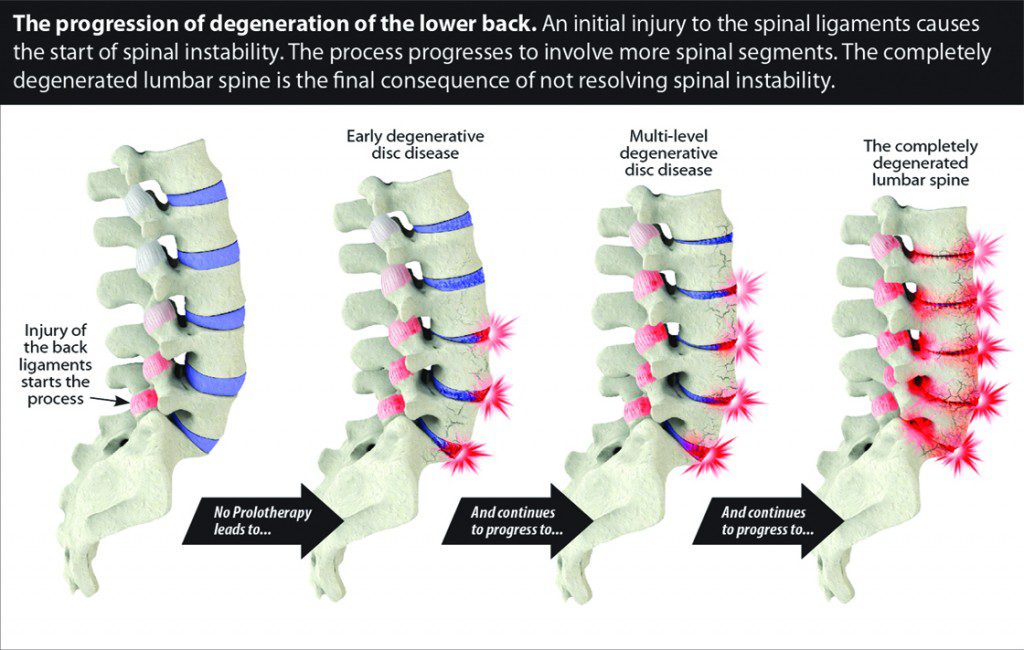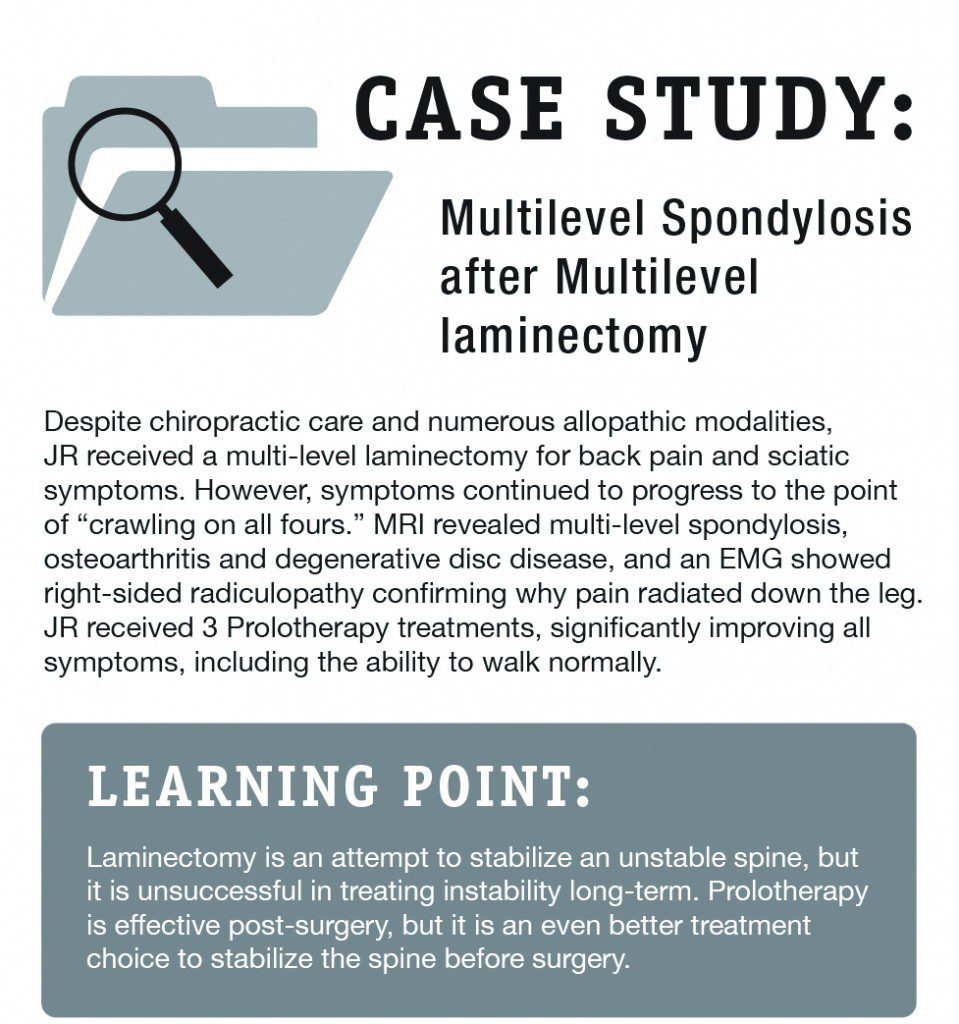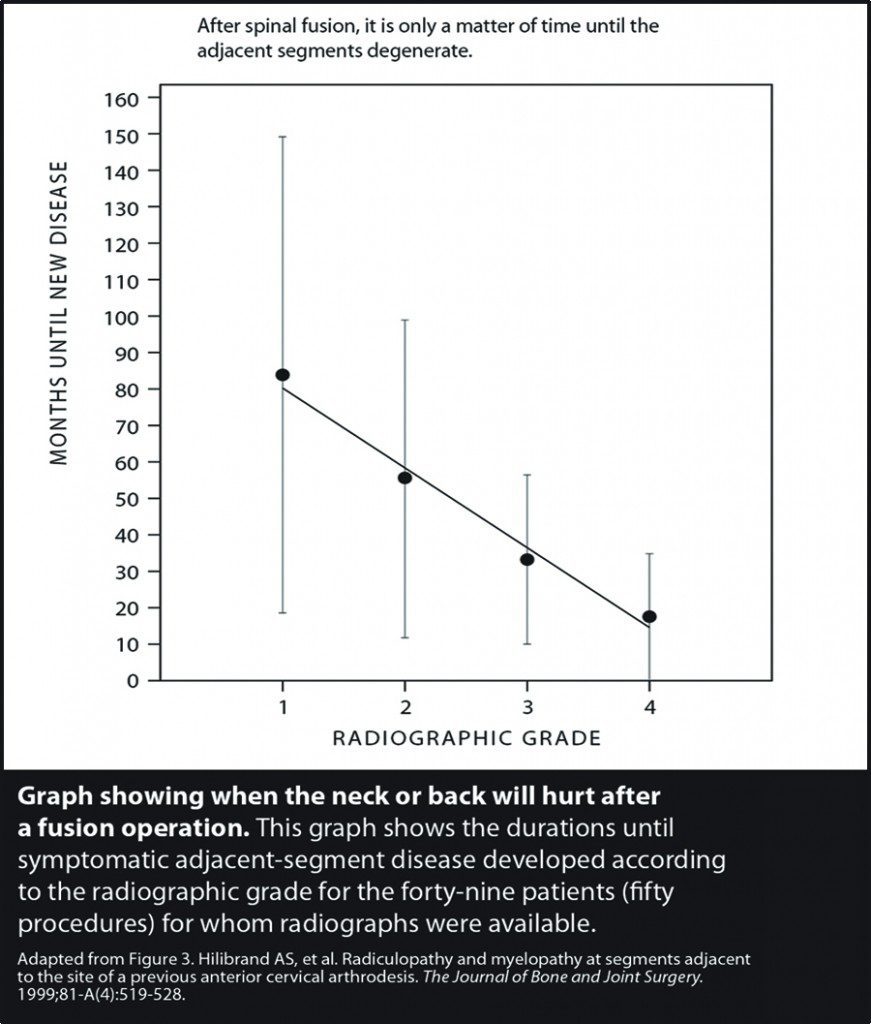By Debra K. Brinker, RN
Many people who suffer with chronic back pain go through the traditional protocols to no avail, because all too often the true underlying cause is not identified. The common denominator for many painful musculoskeletal conditions causing back pain is spinal instability due to injury to the ligaments. Regenerative options can provide solutions that correct the underlying instability, providing a novel approach to alleviating chronic back pain.
Disc degeneration and herniation
Ligaments are structures joining bone to bone, and in the back or spine, connect adjacent vertebrae. Ligaments serve as one of the primary stabilizing structures of the spinal column, providing adequate motion and restricting hypermobility, and, in doing so, protect the spinal column and nerve roots as they exit the spine. Disc degeneration begins when ligaments around the spine are injured. (See Figure 1.)


Instability due to ligament laxity is part of the pathophysiology of common diagnoses, such as degenerated, bulging, and herniated discs. The excessive motion causes abnormal forces and pressure on the discs between the vertebrae, which produces the degeneration of the discs. Disc degeneration eventually leads to osteoarthritis. (See Figure 2.)


Prolotherapy – a game changer for back pain treatment
Our bodies have amazing regenerative capabilities. Physicians who treat joint pain with regenerative medicine techniques utilize regenerative injection therapies to stimulate the body to repair the ligaments. Prolotherapy, which is short for proliferative therapy, is an injection technique using naturally based solutions that cause such a healing effect. Some Prolotherapy solutions may include a person’s own cells, generally known as Platelet Rich Plasma and Stem Cell Therapy. In the case of chronic back pain, regenerative techniques specifically stimulate the repair of the ligaments through which the disc herniates and the ligaments connecting the vertebrae.
Traditional back treatment formulas
If you feel like you’ve been getting cookbook medical recommendations and getting nowhere, you probably are. Many of the modalities used to treat low back pain only provide short term relief, because they do not repair the ligamentous source of the musculoskeletal pain. Common treatments for back pain include cortisone injections, NSAIDs and eventually prescription narcotics, steroids and even anti-depressants, which of course come with their own set of problems.
Additional modalities for back pain relief can include massage and other body work that focuses on the muscles, but with chronic back pain, the pain tends to return. Physical therapy and exercise may provide some help for those whose problem originates with being sedentary or with the muscles. But as discussed, the underlying cause of chronic pain is often the overlooked ligaments, not the muscles. Chiropractic care can provide relief and often shines in acute cases, but when back pain is chronic and frequent adjustments are required due to resumption of pain, ligament injury is often at the root.
Why is back surgery recommended so often?
Having an MRI done may be a fast-track to a surgical recommendation. Many people have abnormal findings on an MRI but have no pain. Therefore, pain must correlate with history and physical examination. Often patients are signed up for surgery because they have an abnormal finding on MRI, resulting in the surgical removal of tissue, such as what occurs during a laminectomy. Removal of tissue without addressing the underlying instability can lead to Failed Back Surgery Syndrome and worsened arthritis. (See Figure 3.)


If fusion has been recommended, it is an acknowledgement of the vertebral instability, because fusion surgery is specifically utilized to prevent motion of the segments that are moving excessively. However, fusion surgery has many unnecessary long term risks and does not resolve the underlying ligament injury. Since spinal motion must come from somewhere, and fusion of two vertebrae causes them to remain immobile, increased activity is required of the segments above or below the fusion, leading to further instability and pain at those levels, and eventually to multi-level fusions. To fuse two vertebrae makes them immobile forever. Therefore, the motion required to do activities is increased on the adjacent vertebral segments and leads to more instability and pain, often leading patients undergo multi-level fusions. (See Figure 4.)


By comparison, regenerative treatments aim to relieve pain by stimulating the body to tighten and strengthen the ligaments naturally, without the installation of hardware or removal of bone, to correct the chronic subluxations and to stop perpetuating the degenerative cycle.
What types of back pain conditions are appropriate for regenerative injection therapies?
Prolotherapy and its cellular cousins, Platelet Rich Plasma and Stem Cell Therapy are helpful for back pain that involves spinal instability: herniated discs, bulging discs, degenerative disc disease, chronic subluxation of the sacroiliac joints, and more. (See Figure 5.)


One of the wonderful things about regenerative therapy for back pain is that the individual can maintain activity and get back to sports or other activities they enjoy, without the need for extensive downtime. Treatments and exercise programs are individually tailored to promote healing and to return people to their active lives. It’s really an amazing transformation to see people regain their mobility and independence!
Regenerative Medicine Specialists
CaringMedical.com
239-303-4546
with locations in Fort Myers and Chicagoland
 Southwest Florida's Health and Wellness Magazine Health and Wellness Articles
Southwest Florida's Health and Wellness Magazine Health and Wellness Articles

